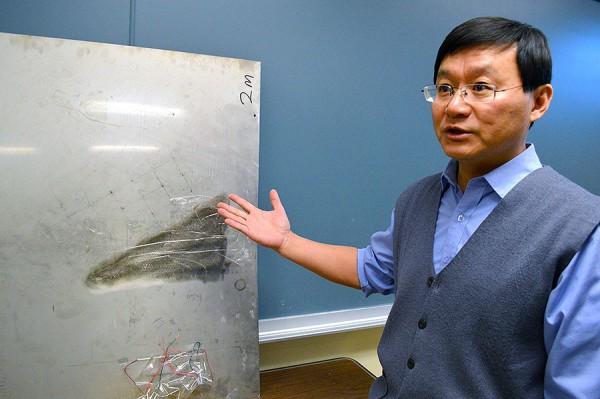Scientists 'bend' elastic waves with new metamaterials that could have commercial applications

Huang developed a metamaterial that refracts acoustic and elastic waves creating possible applications in super-imaging devices. Credit: Shelby Kardell
Sound waves passing through the air, objects that break a body of water and cause ripples, or shockwaves from earthquakes all are considered “elastic” waves. These waves travel at the surface or through a material without causing any permanent changes to the substance's makeup.
Now, engineering researchers at the University of Missouri have developed a material that has the ability to control these waves, creating possible medical, military and commercial applications with the potential to greatly benefit society.
“Methods of controlling and manipulating subwavelength acoustic and elastic waves have proven elusive and difficult; however, the potential applications–once the methods are refined–are tremendous,” said Guoliang Huang, associate professor of mechanical and aerospace engineering in the College of Engineering at MU.
“Our team has developed a material that, if used in the manufacture of new devices, could have the ability to sense sound and elastic waves. By manipulating these waves to our advantage, we would have the ability to create materials that could greatly benefit society–from imaging to military enhancements such as elastic cloaking–the possibilities truly are endless.”
In the past, scientists have used a combination of materials such as metal and rubber to effectively 'bend' and control waves. Huang and his team designed a material using a single component: steel. The engineered structural material possesses the ability to control the increase of acoustical or elastic waves. Improvements to broadband signals and super-imaging devices also are possibilities.
The material was made in a single steel sheet using lasers to engrave “chiral,” or geometric microstructure patterns, which are asymmetrical to their mirror images (see photo). It's the first such material to be made out of a single medium. Huang and his team intend to introduce elements they can control that will prove its usefulness in many fields and applications.
“In its current state, the metal is a passive material, meaning we need to introduce other elements that will help us control the elastic waves we send to it,” Huang said. “We're going to make this material much more active by integrating smart materials like microchips that are controllable. This will give us the ability to effectively 'tune in' to any elastic sound or elastic wave frequency and generate the responses we'd like; this manipulation gives us the means to control how it reacts to what's surrounding it.”
Going forward, Huang said there are numerous possibilities for the material to control elastic waves including super-resolution sensors, acoustic and medical hearing devices, as well as a “superlens” that could significantly advance super-imaging, all thanks to the ability to more directly focus the elastic waves.
The research began five years ago during Huang's tenure at the University of Arkansas-Little Rock and was funded by a grant from the U.S. Air Force Office of Scientific Research. Byung-Lip (Les) Lee served as program manager. The study, “Negative refraction of elastic waves at the deep-subwavelength scale in a single-phase metamaterial,” recently was published in Nature Communications.
Editor's Note: For more on this story, please see: http://engineering.
Media Contact
All latest news from the category: Materials Sciences
Materials management deals with the research, development, manufacturing and processing of raw and industrial materials. Key aspects here are biological and medical issues, which play an increasingly important role in this field.
innovations-report offers in-depth articles related to the development and application of materials and the structure and properties of new materials.
Newest articles

First-of-its-kind study uses remote sensing to monitor plastic debris in rivers and lakes
Remote sensing creates a cost-effective solution to monitoring plastic pollution. A first-of-its-kind study from researchers at the University of Minnesota Twin Cities shows how remote sensing can help monitor and…

Laser-based artificial neuron mimics nerve cell functions at lightning speed
With a processing speed a billion times faster than nature, chip-based laser neuron could help advance AI tasks such as pattern recognition and sequence prediction. Researchers have developed a laser-based…

Optimising the processing of plastic waste
Just one look in the yellow bin reveals a colourful jumble of different types of plastic. However, the purer and more uniform plastic waste is, the easier it is to…



